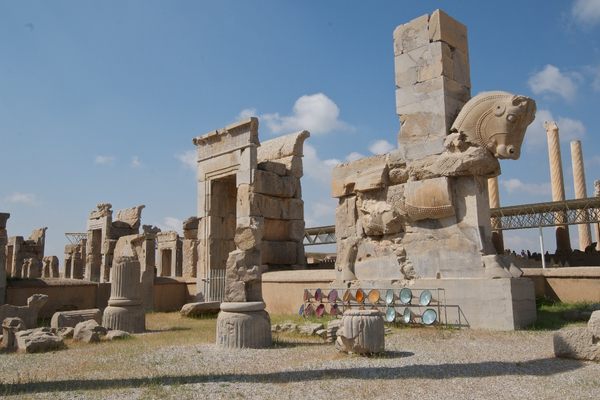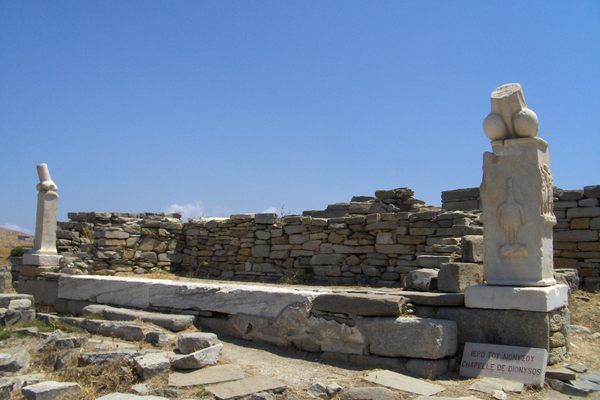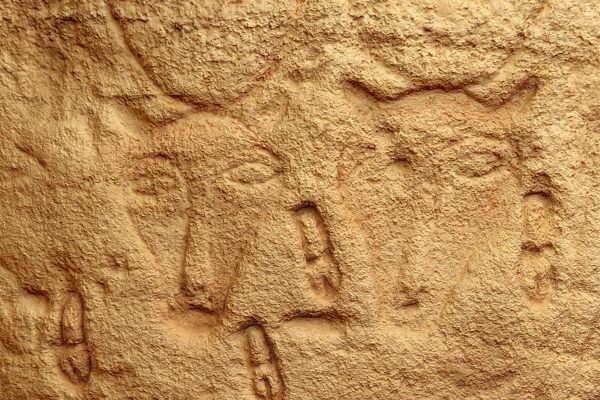Nine Places To See the Ruins of Ancient Religious Cults
Ancient religion was strange and fierce.
Ancient religion was bloody, sexy, and chaotic. Gods competed with gods, priests with priests, and prophets with prophets. Religion was personal; gods had to earn your business. And the battle for worshipers was fierce: Rome imported promising religions from all over the world. Persian deities were worshiped as far afield as Britain. In Egypt, a ritual transformed pharaohs into gods. When it came to the divine, many ancient societies were omnivorous.
This divine melting pot has left a string of bizarre sites scattered across the world: a temple with astonishing secrets in Egypt, a musical stone in the mountains of Azerbaijan, and an island covered with gigantic broken phalluses in Greece. Here is an introduction to nine of the most marvelous ancient religious sites.
1. The Oracle of Delphi
DELPHI, GREECE

On the slopes of Mount Parnassus, at the very center of the ancient Greek world, the Oracle of Delphi lay hidden. Underground, beneath the great Temple of Apollo, a priestess sat above a chasm in the earth. Vapor rose up and the priestess, called the Pythia, breathed deeply and fell into a trance. Then she spoke the words of the god.
Many scholars believe that the vapors she inhaled had hallucinogenic properties. It is certainly possible that they contained ethylene, known to induce trances, out-of-body experiences, and occasional spasms in subjects. The Pythia’s prophecies were opaque, often ambiguous—but for over 12 centuries, people traveled to Delphi in search of counsel. “I know the number of grains of sand,” said the Oracle, “and the measure of the sea, and I can understand the mute, and hear those who do not speak.”
Herodotus reported that Croesus, the obscenely rich king of Lydia, asked the Pythia whether he should make war on Persia. The Oracle replied that if he did, he would destroy a mighty empire. Croesus went away rejoicing—but the empire he destroyed turned out to be his own.
Later visitors treated Delphi with less respect. Alexander the Great marched to Delphi to consult the Oracle before departing for Asia. According to Plutarch, since the Oracle took the winter off, he was told to return in three months. Enraged, Alexander grabbed the priestess by her hair and dragged her into the temple—only letting go when she cried out, “You are invincible.” Nero, Pausanias reports, stripped the sanctuary of its treasures—picking out no less than 500 statues to take back to Rome as souvenirs.
Delphi was finally destroyed by the Christian Emperor Theodosius I in 390 CE, in an attempt to eradicate all traces of the old pagan beliefs. Today, the ruins of the Temple of Apollo still cling to the slopes of Parnassus. Though few traces of the Oracle remain, it is one of the eeriest and most evocative sites in the ancient world, a place of ghosts and mist.
2. The Temple of Dionysos
DELOS, GREECE

Gigantic marble phalluses, broken yet imposing, are dotted around the Temple of Dionysos on the Greek island of Delos. While the Temple of Apollo at Delphi had “nothing in excess” carved into it—a idea which underpinned much of Greek thought—Dionysos was a very different kind of god: at home with wine, celebration, and every kind of excess.
Across ancient Greece, Dionysos was worshiped through phallika: processions which wound their way through the countryside, bearing gigantic phalluses with them, the worshipers yelling obscenities as they went. (Aristotle suggested that the comic theater may have been born from these processions.) Few, though, matched the festival of Dionysos held in Alexandria in 275 BC. There, a 180-foot-long gold-plated phallus made its way in a procession through the streets of the city, flanked by elephants, a rhinoceros, and a giraffe—and decorated, as Athenaeus reported it, with ribbons and a gold star.
Many Victorian visitors to Delos thought that the ancient Greeks were full of “sweetness and light,” as Matthew Arnold put it—and the unmistakable sexuality of the Temple of Dionysos made them squirm. Sir Grenville Temple’s Travels in Greece studiously ignored the giant phalluses of Delos, waxing lyrical about a statue of Apollo, and his “curls” instead. Today, though, Delos is one of the best places to glimpse the wild side of ancient religion. The gods of Greece drank outrageously, and dragged one another into bed at every opportunity. They were worshiped accordingly.
3. The Great Temple
ABU SIMBEL, EGYPT

The Great Temple of Abu Simbel looms up out of the desert, in the far south of Egypt. It is an awe-inspiring monument to Rameses the Great, one of the most powerful of all the pharaohs—and is over 3,000 years old, completed around 1244 BC. Its most amazing secret, however, lies hidden in its innermost chamber—and can only be glimpsed on two days every year.
Four colossal statues of Rameses, each 20 meters (66 feet) high, line the front of the temple, staring down coldly on those who approach. It was Rameses who became the model for Percy Shelley’s “Ozymandias”: “My name is Ozymandias, king of kings: / Look on my works, ye Mighty, and despair!” In the 30th year of his reign, Rameses underwent the Sed ritual, transforming himself into a god. Abu Simbel was Rameses’ celebration of his own greatness and divinity.
Long after Rameses’ reign, sand swept over the Great Temple—and it vanished into the desert for centuries until it was rediscovered in 1813. In the 1960s, the temple was moved wholesale to accommodate the Aswan Dam—its statues cut into three-ton blocks and lifted to safety. In spite of all this, the greatest secret of Abu Simbel has endured. Rameses’ craftsmen built it along the axis of the sun—and designed it so that twice a year, at dawn, light would flood into the temple’s innermost sanctum. And Rameses’ architecture still keeps time today.
Every year, on February 22 and October 22, crowds gather to witness the sunrise. In the innermost room of Abu Simbel, light floods in. And, just as it did over 3,000 years ago, the morning sun illuminates three of the four statues waiting there, each in turn. Ra, god of the sun; Amun, the great god of Thebes; and Rameses himself. Only the fourth statue, of Ptah, the mysterious creator-god, is left in shadow. The wonder which watchers feel today has a different cause to that felt by the ancient Egyptians—delight at Rameses’ crafty monument, rather than religious ecstasy—but Abu Simbel remains a place of awe.
4. The Musical Stone of Gobustan
QOBUSTAN, AZERBAIJAN

In the mountains of Azerbaijan, in a place as strange and harsh as the deserts of Abu Simbel, is another ancient religious site which still exerts fascination. Here, southwest of Baku, volcanoes belch forth mud, and an otherworldly landscape unfolds. Six thousand prehistoric rock paintings are scattered amongst the caves and outcroppings: hunters stare at their prey, dancers whirl, and battles unfold. Here, the Gaval Dash, the Musical Stone of Gobustan, may be found.
The Gaval Dash is around two meters (7 feet) long, with a slightly curved surface. When it is hit with other, smaller stones, it makes a sound like a tambourine. The note varies depending upon where the stone is hit. While its ancient significance is not known precisely, it is thought to have been a sacred object for prehistoric societies—and to have played a key part in religious rituals.
The Musical Stone has also found a new life, not so distant from its ancient purpose. In prehistoric Azerbaijan, its music may well have accompanied the chain-dances depicted on nearby rock-paintings. In modern Azerbaijan, the Musical Stone accompanied performers at the 2008 Eurovision Song Contest in Baku. Eurovision—with its sequins, baby oil, brutally overproduced pop, and 170 million viewers—is as close as the continent gets today to mass religious hysteria.
5. Pluto’s Gate: Ancient Portal to the Underworld
HIERAPOLIS, TURKEY

Solemn and mystical only from a distance, many ancient places of worship, on close inspection, reveal their true trashy, crowd-pleasing nature. In the south of Turkey, one such site has recently been rediscovered. Pluto’s Gate was advertised by its priests—who appear to have been ancient students of the principles of P.T. Barnum—as the gateway to the Underworld itself. It was a narrow, foul-looking crevice, a little over a meter wide, which belched forth toxic fumes day and night.
In the ancient world, Pluto’s Gate was rather like the roadside attractions of 1960s America: a low-budget guilty pleasure for passing travelers. Visitors would stand at the railing around the crevice, and purchase birds and animals to fling into the depths of hell. The unfortunate creatures would almost immediately choke to death from the noxious fumes—a sight chronicled with delight by many ancient writers.
In the first century CE, the Greek historian Strabo captured the ghoulish carnival around Pluto’s Gate in his Geography: “This space is full of a vapor so misty and dense that one can scarcely see the ground. […] Any animal that passes inside meets instant death. Bulls that are led into it fall and are dragged out dead; and I threw in sparrows and they immediately breathed their last and fell. But the Priests of Cybele, who are eunuchs, pass inside with such impunity that they even […] descend into the opening to a certain depth, though they hold their breath as much as they can (for I could see in their countenances an indication of a kind of suffocating attack).”
6. The Kaali Meteorite Crater Field
KAALI VILLAGE, ESTONIA

Egyptologists have unraveled the mysteries of the time-keeping temple of Abu Simbel—and the rites of Delphi have been documented by many Greek and Roman authors. But some ancient religious sites remain enigmas. None more so than the gigantic craters which meteorites blasted across the Estonian island of Saaremaa around 7,500 years ago.
Nine craters remain. The largest is some 110 meters (328 feet) wide. Bronze Age fortifications and heaps of animal bones have been discovered around it—suggesting that it was an important site for worship and sacrifice in ancient times. Almost nothing is known, however, of just which gods were worshipped there—or what form the rituals took. There are no written records. The main crater is clogged with oak trees and full of stagnant water, making large-scale excavation virtually impossible.
That has not prevented speculation running riot. Some have attempted to connect the meteorite impacts—which must have been witnessed by many people—with the Greek myth of Phaeton, son of Helios the sun-god. Phaethon borrowed his father’s flaming chariot—but could not control it. Rivers and lakes began to burn, and whole cities caught fire, as he shot across the skies in flames. Finally, he toppled from the heavens. As Apollonius told it, “Phaethon, half-consumed, fell from the chariot into the opening of a deep lake; and even now it belches up heavy clouds of steam from its smoldering wound.”
7. The Temple of Mithras
LONDON, ENGLAND

The Mysteries of Mithras were celebrated in windowless temples, underground, far from the sight of the world. In ancient Rome, they were whispered about in the same way that the Freemasons are today: there were secret handshakes, strict initiation rites (some temples had a so-called ‘ordeal pit’ for the purpose), and seven levels which worshipers could rise to. Each grade, from Raven (Corax) up to Father (Pater) had its own costume—and ceremonial mask.
Romans first encountered Mithras in Persia—and his cult was soon adopted obsessively by the Roman army. Mithras travelled across the Mediterranean, then north and west to the borders of Rome’s power. Garrisons built temples to Mithras on Hadrian’s Wall, in the far north of England—as well as at the heart of modern-day London, thousands of miles from where this god began his journey in Persia.
A few steps from the Stock Exchange and the Bank of England, London’s Mithraeum has in fact been moved from its original site—now covered by development—and rebuilt here. It is a very different kind of temple to the rich grandeur of Delphi and Abu Simbel: a simple rectangular building made of stone, where no light shone, and the god waited in darkness to whisper the secrets of the world.
8. The Palace of Persepolis
PERSEPOLIS, IRAN

Persepolis was one of the glories of the ancient world: the richest city on Earth, and the capital of the Achaemenid Empire. At its heart lay the royal palace of the Great King of Persia—a wonder of gold and silver, ivory and precious gems, wrought by the finest craftsmen from every corner of the known world. But the palace of Persepolis was also a holy place—and for Persia’s Zoroastrians, it was one of the most sacred spots in the entire empire, a focus of worship and reverence.
In 330 BC, Persepolis was captured by Alexander the Great. Before he left the city, he ordered the Great King’s palace burned to the ground—whether through sudden malice or sober calculation, it is impossible to be sure. Ancient authors give conflicting accounts—some arguing that Alexander burned Persepolis as an act of vengeance for Persia’s invasion of Greece, others insisting that he did it when hideously drunk, at the instigation of an Athenian courtesan, Thais.
Persepolis was undoubtedly an important religious site. But after its destruction, generations of Zoroastrian authors added loss to loss—claiming that the only full copy of the Avesta, the sacred text of Zoroastrianism, had been consumed by the fire. There’s no evidence that this actually happened—but for over 2,000 years, many Zoroastrians still saw Alexander as history’s greatest villain. As the Book of Arda Wiraz states:
“The accursed Alexander came to the country of Iran with severe cruelty and war and devastation; he slew the ruler of Iran, and destroyed the metropolis and empire, and made them desolate. […] All the Avesta was written upon prepared cow-skins with gold ink, and was deposited in the archives in Persepolis. […] Alexander, the westerner, who was dwelling in Egypt, burned them up. And he killed several high priests and judges and upholders of the religion, and the competent and wise of the country of Iran. […] At last, self-destroyed, he fled to hell.”
9. The Mayan 2012 Prophecy Carvings
VILLAHERMOSA, MEXICO

Instead of fading into oblivion, many ancient religious sites, like the palace of Persepolis, have only gained in significance in later centuries. Of course the stories told about them are not always strictly true. Later cultures are prone to shameless misreading: burying the frank sexuality of Greek religion in “sweetness and light,” for instance—or even turning an innocent calendar into a promise of the apocalypse. Such was the fate that befell the Mayans.
December 21, 2012, marked the end of a 5,126-year cycle of the Mayan Long Count calendar. On one particular pillar, preserved in the Carlos Pellicer Museum in Villahermosa, Mexico, this date was marked by the cryptic phrase: “He will descend.” After this, the calendar inscribed on the pillar ran out. Was December 21, 2012 the end of time? It was enough to set the doomsday theories spiraling.
Of course, certain details had to be ignored along the way: other Mayan monuments referred to dates long after 2012, for instance—and none of the key Mayan texts which have survived mention an impending doomsday. The wilder theories—of geomagnetic reversal, or wandering alien planets—could not, the experts politely remarked, really be called science. And of course, December 21, 2012 came and went, and the world spun on.
The tales told about these ancient religious sites have made them into places of fascination, centuries after their old gods faded, or moved on. But such stories can lead readers astray as easily as they can enchant. Memory is not so far from misdirection, after all.



















Follow us on Twitter to get the latest on the world's hidden wonders.
Like us on Facebook to get the latest on the world's hidden wonders.
Follow us on Twitter Like us on Facebook